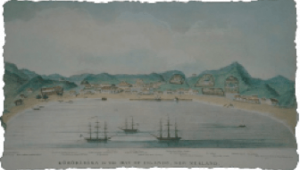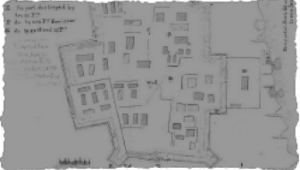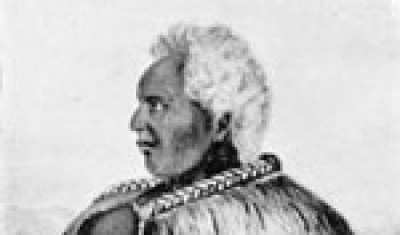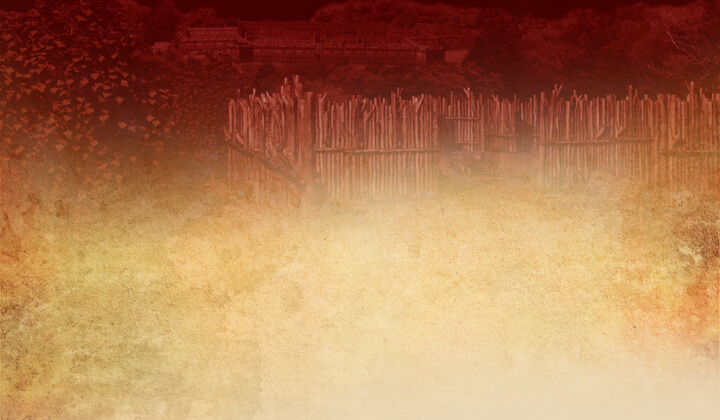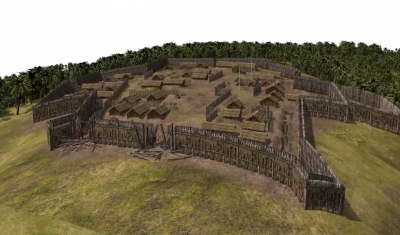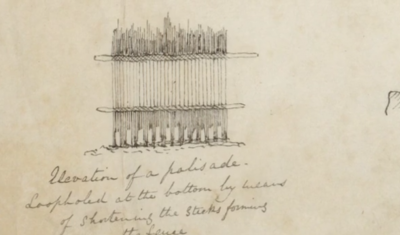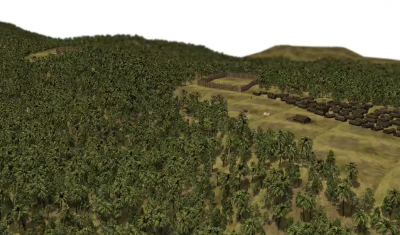
Ruapekapeka Pā



Ruapekapeka is located at the low northern end of the Tapuaeharuru ridge, about 15 kilometres from the sea as the crow flies. From the perspective of a British soldier in the 1840s, it was not an easy place to get too. There was no road or track. The soldiers had to cut their way south from the Kawakawa inlet though more than 20km of dense forest, building a road to transport the heavy artillery, ammunition and supplies. Of course, the difficult access was not an accident. Te Ruki Kawiti did not intend to make life easy for his enemies.
Kawiti chose a broad knoll surrounded by thick puriri forest as a building site for Ruapekapeka Pā. The land falls away to the north, east and west into low undulating terrain. The pā is about 90 metres long by 65 metres wide, extending across the relatively flat area on top of the knoll. In plan view Ruapekapeaka is shaped like a skewed rectangle, with wide rectangular extensions projecting from two sides. Flanking gun pits extended from the north-western and north-eastern corners, and there was a triangular bastion projecting from the southern side. The pā was designed so that the defenders could direct flanking fire at an enemy attacking from almost any angle.
Around the perimeter of the pā were two closely placed rows of timber palisades, forming a double wall about three metres in height. Designed to resist the heavy guns, many of the posts were entire tree trunks with their limbs hacked off, approaching half a metre in diameter. The posts were sunk deep into the ground, and the spaces between them were filled with saplings and split timbers firmly held together with cross rails and torotoro. The outer wall was padded with bundles of green flax, which deadened the impact of musket fire and masked any damage to the palisades behind. At the very base of the palisades were gaps and loopholes, so a warrior crouching in the ditch behind could fire his musket at the enemy without exposing himself at all. Some of the palisades were still standing in 1919 when James Cowan visited the site, and he noted that the outer defences “must have presented a formidable face to the attacking force.1
There were (we think) five gateways in the perimeter defences formed by narrow gaps in the palisades. The gateways were cleverly designed, so that the gap in the outer row of palisades was off-set from the gap in the inner row. This meant that the palisades presented an unbroken line of defence, while allowing the defenders to enter and exit the pā quite easily. There were additional defences to the rear of the pā, shown on a beautiful map drawn by Mister Nops. He shows breastworks and a maze of felled trees – defences at the rear which were probably intended to cover a withdrawal.
Behind the walls there were inter-connected ditches all the way around the perimeter for the musketeers. At the front of the pā the double-palisade was external to the ditches. Spoil from the excavations was heaped up along the interior edge to form an earthen wall, shown clearly in the photo below. The ditches at the rear were in the gap between the palisades, or else there was a third row of palisades on the interior. The photo also shows that the trenches were broken up with alternating earthen projections. This meant that the defenders could easily move around within the trench, but they were protected against deadly enfilade fire. In other words, an enemy who gained access could not fire lengthwise down the entire trench.
The interior of Ruapekapeka Pā was designed to protect the inhabitants from artillery fire, and to provide successive lines of defence within the pā should the enemy gain entry. Artillery fire was a real problem because the pā sloped downwards to the west and the north. This meant that the interior was exposed to British artillery from that angle. Kawiti addressed this issue by going underground. He built “bomb-proof” bunkers, with narrow entrance tunnels roofed with logs and earth. Below the surface the tunnel expanded into wide chambers, large enough to accommodate several people in safety if not in comfort. The bunkers were connected to each other and to the perimeter trenches by way of tunnels, so the defenders could safely more around within the pā. Cyprian Bridge wrote and entry in his diary about the strength of the interior defences:
I found the pa much stronger in its interior defences than the one at Ohaeawai, but the outer fences and ditches were very similar, and all the fences were flanked. There were also deep holes underground all over the pa, which were so constructed as to be bomb-proof, in which the men screened themselves from the shot and shell – and cross fences and breastworks inside, so that a fire could have been kept up on us even had we succeeded in forcing the outer fences by storm, as we advanced in to the interior of the pa, which must have proved destructive had we not taken them so much by surprise.2
There were houses inside the pā as well, some without underground bunkers. They were built low to the ground, with earth piled up against the exterior walls to provide at least some protection. The pā had two wells to ensure a constant water supply, one inside the defences and another just outside. One of the wells (the outside one) is still open today. The interior well has since caved in, although a recent geophysical survey of the pā offers some evidence as to its location.3 The warriors (and the women and children who accompanied them) did not necessarily live inside the pā during the whole of the bombardment. There was a little village a safe distance behind the pa, shown clearly on the plan drawn by Mr Nops.
There is no question that Ruapekapeka Pā was a masterful example of military engineering. For days, the defences withstood a heavy bombardment, but even the strongest timber posts cannot stand up against 32-pounder cannon balls forever. Even after the palisades were breached, the pā remained a formidable fortification. The anticlimactic end to the battle begs some interesting questions. Why was the pā nearly empty at the time of the British attack? What would have happened if the soldiers had tried to storm the pā a day earlier, as Colonel Despard had wanted to do? What if the defences had been properly manned when the soldiers finally did gain access?
Ruapekapeka Pā is a site of significant engineering innovation. At a time when British military technology led the world, this Māori reaction to the threat of artillery bombardment represents an ingenious indigenous response to European firepower.
Institute of Professional Engineers New Zealand
Written on a plaque unveiled at Ruapekapeka in 2008
